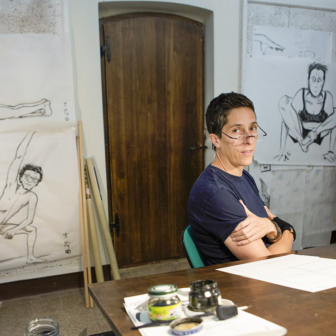The First Dismissal
Luke Slattery | Penguin Specials | $9.99
A Forger’s Progress: The Life of Francis Greenway
Alasdair McGregor | New South | $49.99
Have you ever wondered why the old Supreme Court in Sydney is such an unprepossessing building? Why it’s wedged behind a church and seems so ad hoc? Although it lacks the grandeur of the equivalent courts in other states, the history of its construction tells a terrific story about the machinations and personalities at play when the city around it was being formed. It takes us right into the heart of governor Lachlan Macquarie’s penal colony when his authority was being undermined by an emissary of the British government and his relationship with the emancipated architect, Francis Greenway, was dissolving.
Like two ships that take different routes but arrive at a distant port on the same day, these books bring slightly different versions of the same news. Luke Slattery’s sleek ketch of a book focuses on the undoing of one of Australia’s most important early governors and explores the role played in that story by Australia’s first architect. Alasdair McGregor has skippered an imposing three-master that focuses on Greenway and places him in the context of Macquarie’s Sydney.
Read separately or together the two books explain the turbulent nation-making period between 1810 and 1821. They also reveal how Macquarie and Greenway were brought down by an unlikeable official called John Thomas Bigge, who was sent by the Earl of Bathurst to rein in the colonial administration. It was the British government’s view that Macquarie had become too progressive and the colony was no longer the place of terror the Crown required to maintain social order at home. Bigge set out to prove that this was the case.
According to Slattery, Sydney was in the throes of a kind of revolution, driven by an almost noble Macquarie who saw redemptive qualities in convicts and promoted people with talent, regardless of their station in life. Among the “exclusives” and free settlers in the colony, who saw convicts as a resource for their own enrichment, his ideas were considered more than dangerous. The likes of the wealthy pastoralist John Macarthur complained to London and filled Bigge’s head with stories of Macquarie’s excesses, and when the commissioner’s report was tabled in the House of Commons in 1822 the many achievements of the preceding decade were sullied.
Slattery provides a rounded description of Macquarie in an effort to explain how he managed to rise above at least some of the attitudes of the Regency period. As a member of an ancient Scottish family, his experience of losing and recovering his family farm may have contributed to an understanding of self-advancement and the power of rehabilitation. Although he sanctioned at least one reprisal attack on Aborigines, he generally tried to instil civility by emancipating convicts and encouraging them to prosper in the new world. He resisted the prevailing idea that “everyone had a place and in those places they should remain.”
McGregor is more critical of Macquarie. He acknowledges his ambitious building plan but slowly creates a sense that the governor’s priorities were sometimes skewed and that some of his monuments – many of which were the work of Greenway – were a bit ridiculous. The odd castellated Fort Macquarie at Point Bennelong, where the Sydney Opera House now stands, was a case in point. The excessive Government House stables were lampooned as a “palace for horses.” Macquarie dithered over the construction of the important Parramatta Women’s Factory while other less important buildings were erected. And all the while he played a game with London, deliberately telling them very little at all, or so so late that the Colonial Office had little option but to approve works that were already near completion.
McGregor doesn’t argue that any of this justifies the way Macquarie was treated, but it certainly does explain some of Bigge’s frustrations. For Slattery, though, Bigge’s treatment of Macquarie was an outrage and his dismissal every bit as reactionary as the sacking of Gough Whitlam over 150 years later. Either way, we’re left wondering whether Macquarie was an egalitarian, a liberal visionary or a schemer with an edifice complex. Or all of the above.
Greenway is more than a bit-player in Slattery’s book, but he is not perhaps as central as the cover of The First Dismissal suggests. The architect was important to Macquarie because a functioning society required permanent buildings, but he was only one of many convicts given preferment by the governor. And while the building program was an important focus of Bigge’s report, the commissioner also questioned many other aspects of Macquarie’s administration.
McGregor provides the deeper insights into this troubled architect, such as the intriguing connection between Greenway and Arthur Phillip, the first governor of New South Wales. Phillip had retired close to Greenway’s home near Bristol and was in the last years of his life when he supposedly became acquainted with the scheming local architect, who had never been anywhere near Sydney at this point. Might Phillip have been one of those who interceded in 1812 to save Greenway from the gallows?
McGregor postulates, while acknowledging just how strange it sounds, that the young Greenway became enthralled by the blank canvas of New South Wales after meeting and hearing the reminisces of Arthur Phillip, and that this might explain his crime of forgery. Through this “obtuse logic,” transportation offered Greenway freedom from bankruptcy and the opportunity to imbue his life with meaning.
McGregor also speculates whether Greenway’s letter of introduction from Phillip was a forgery. The letter was crucial in winning over Macquarie and eventually winning the job of acting civil architect. Its veracity could not be confirmed because Phillip died soon after Greenway arrived in the colony.
Greenway had deep character flaws. He had an inflated sense of self-importance; he lacked tact and easily became embittered; he was prone to ranting and historical revisionism. Yet he produced the seminal architecture of colonial Australia. His designs had the clean lines of the Georgian period, as well as a gravitas and a lightness. His surviving works include the graceful St Matthew’s Church in Windsor, the bold convict barracks at Hyde Park and, of course, the elegant St James Church, right next to the Supreme Court. A replica of his lighthouse stands on Sydney’s South Head.
Commissioner Bigge pursued his mission to curb Macquarie for over a year. Before long he started meddling with the Supreme Court and other building projects. As McGregor points out, he soon demonstrated that he had no skills in town planning. Macquarie was transformed into a lame duck governor and, although Greenway clung on for a short time after his patron’s departure, his own career was also effectively finished. Ultimately a sad figure, Greenway died in obscurity on the property granted to him by Macquarie in the dying days of his administration. There is no known grave.
I’m not picking a favourite. Can I suggest you read both? Start with The First Dismissal and then zero in on Greenway in The Forger’s Progress. I can promise you a rich understanding of a defining decade and some memorable insights into the strange relationship between two giants of early Australia. •




